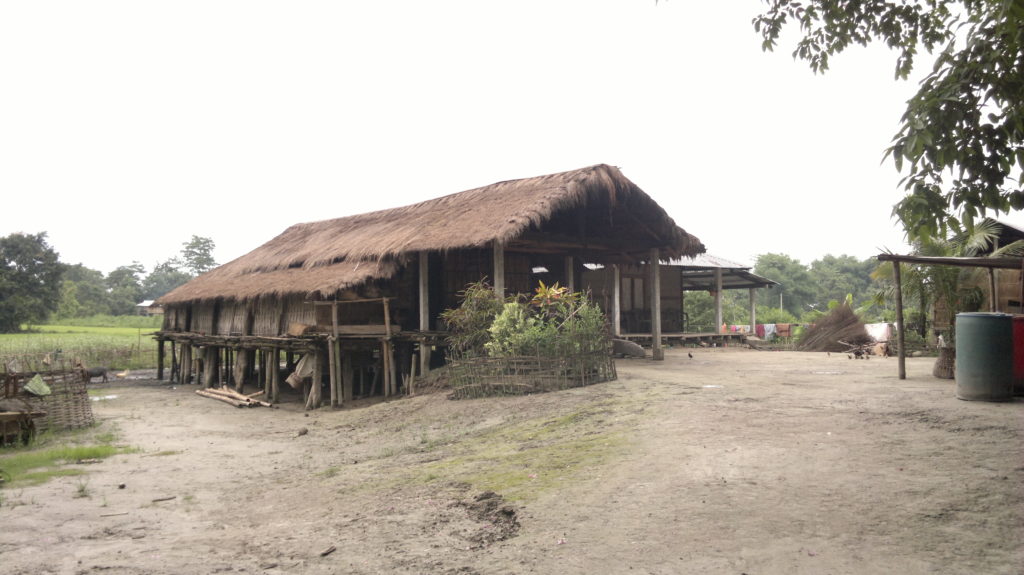Majuli, one of the largest river islands in the world has been in the news for last several years for the consistent bids to the World Heritage Committee, UNESCO for World Heritage status. The World Heritage Committee not only decides whether a property is inscribed on the World Heritage List, but also defines the use of the World Heritage Fund and allocates financial assistance upon requests from the States Parties. That is why its inscription assumes an added dimension. The Committee can however defer its decision and can request for further information on properties from the States Parties. This happened in the case of Majuli. The World Heritage Committee sought further data on the nominations each time. World Heritage Committee also examines reports on the state of conservation of inscribed properties and asks States Parties to take action when properties are not properly managed. It also deletes properties from the list of World Heritage in case such properties are in danger or not properly managed by the state party. So getting the World Heritage status is not the end; it has to be maintained by the concerned government too. A government cannot wash off its hand after getting a site inscribed as World Heritage. It has to carry on the work outlined in the Comprehensive Development Plan it submits to UNESCO alongwith the dossier.
In the present case, India being a state party of the World Heritage Committee makes it further obligatory on the part of India to be more serious in the matter of selecting sites for World Heritage status and maintaining these sites thereafter. If Majuli is selected as World Heritage and not maintained well thereafter, it will run the risk of losing the World Heritage status in no time. This already happened once in Assam in case of Manas Wildlife Sanctuary, which had been declared a World Heritage Site in December 1985 and then put on the list of sites in danger in 1992 due to rampant poaching and felling of trees by the extremists. However the situation improved and it was back to the normal list since June 2011. It was also declared a national park by Government of India in 1990. In view of all these, we need to seriously focus on the factors that have stood as hindrance to obtaining the World Heritage status for Majuli. Getting the World Heritage tag cannot be an end in itself, if there is no follow up action. Inscription of a site on the World Heritage List is only a means to increase awareness about its preservation, the onus lying equally on the government and citizens. Heightened awareness is expected to lead to a general rise in the level of protection and conservation of the heritage site. In any case it is a global problem. In 2016, as many as 48 sites across the world are in the danger list.
As in 2016, there are 1031 properties around the world in 163 countries which have been recognized as World Heritage Sites. 192 countries in the world abide by the World Heritage Convention of UNESCO, adopted on November 16, 1972. These 1031 World Heritage Sites include 802 cultural, 197 natural and 32 mixed sites. India has 32 World Heritage Sites. Another 46 sites of India have been submitted in the tentative list. That means these 46 sites are in the waiting list for nomination to World Heritage Committee. Obviously there is tough competition among the sites. There are pressure from different states on the Government of India to forward sites in this Tentative list located within their states to UNESCO. As in 2016, there are total 1641 sites from 175 countries in the Tentative list.
Even the sites in the tentative list are entitled to financial assistance from the World Heritage Committee. Study of all these sites across the world give out that all of them have a universal appeal, which is very essential for a site to get World Heritage status. We have to remember that UNESCO will not give importance to Majuli as a mere island, that too with inherent instability due to the erosion problem. We have to highlight the cultural treasures unique to it. The very fact that cultural sites happen to be the dominant section among the entire World Heritage Sites prove that the World Heritage Committee gives a lot of importance to the cultural factor in deciding about the nominations. We can say confidently that Majuli has to be presented as a cultural property, not as a natural property. The very fact that Majuli is one of the biggest river islands in the world is of little value and of no consequence in itself in the reckoning of World Heritage Committee. But since the peculiar geography adds to the attraction of Majuli, it is a fine blending of culture and geography, thereby making it a suitable candidate in the cultural landscape category.
If we have to present Majuli as a cultural property or site, there is no choice but to rely on the Vaishnavite culture developed by Srimanta Sankaradeva and his followers there. Srimanta Sankaradeva had set his feet in the land mass of Majuli in 1522 and stayed there till 1539. The great Sattra institution, founded by him in 1468 at Bardowa for the first time for preaching Eka Sarana Nama Dharma and replicated in Dhuwahata Belaguri of Majuli in 1522 has flourished in this river island till today. However at that time Majuli was not an island as it was then joined to the South bank of Brahmaputra. It was severed from the South bank only by a severe flood known as Shaka-Shakini in Assam history. This event took place in 1691. Thereafter it became isolated from the mainland of the Brahmaputra valley. Because of that, the followers of Eka Sarana Nama Dharma considered it as a safe place to stay in, since royal persecution was common place during the medieval era. When the Ahom royalty accepted the Shakti cult as the state religion and started prosecuting the Vaishnavites, the followers of Srimanta Sankaradeva had to run for shelter in safe places. Majuli was such a safe place.
Over time many Sattras came up in Majuli. At one time there were as many as 64 Sattras in Majuli, because of which it was called Etaka Mahantar Sthan. Now almost one-third of them, that is 22 Sattras have survived while the rest have either disappeared due to erosion or shifted to the mainland. If the small new Sattras set up in recent times are included, the figure stands at 31. All these Sattras depict the unique cultural elements like the classical dance, music etc innovated by Srimanta Sankaradeva in addition to maintaining the social structure introduced by him among the society of the devotees. Sankari dance or Sattriya dance created by Srimanta Sankaradeva is one of the eight classical dance forms of India. Majuli has preserved the original form of this dance form over the centuries. How the Vaishnavite culture has been preserved and continued in the Sattras of Majuli has to be highlighted with evidence in the nomination dossier. The isolation of Majuli helped the Sattras in the island to preserve the culture properly. So they are now considered as yardstick for Sankari culture.
Majuli has become what it is today only because of the over-whelming presence of the Sankari culture in its socio-cultural life. That is the uniqueness of Majuli. The legacy of Srimanta Sankaradeva makes Majuli unique. The management pattern evolved by the great saint has been maintained by some of the Sattras. This pattern consists of decentralized decision making, decentralized leadership development, imparting of vocational skills, preservation of culture, propagation of knowledge etc. Even among the existing 31 Sattras, those Sattras which have maintained the management pattern of Srimanta Sankaradeva and preserved the cultural elements of Eka Sarana Nama Dharma properly, have to be highlighted in the dossier. Just the fact of being a Sattra, however old it be, does not entitle an institution to be a torch bearer of the Srimanta Sankaradeva’s legacy if it has not upheld the traditions properly.
The dossier must be a document highlighting the Srimanta Sankaradeva legacy. Therefore a special sectio~ on it has to be there, with ample proof and adequate number of photos. There has to be photos on Nam-Prasanga, Sattriya dance, Sankari architecture, practice of Bargeet, Ankiya Bhaona, use of costumes, manufacturing of handicraft items etc. All these features have to be duly explained with explanatory notes. The growth and importance of the Namghar institution has to be elaborately explained in the dossier. Sattriya Nritya’s evolution and how it gave rise to other classical dance forms like Manipuri Nritya, has to be mentioned. Sufficient research inputs have do go into the preparation of the dossier to make it worthwhile.
Majuli Cultural Landscape Management Authority (MCLMA) is a body formed by the Government of Assam to look after the developmental activities in Majuli. It should necessarily involve an expert on Srimanta Sankaradeva traditions in the Committee for Endorsement of the Nomination Dossier to be sent to UNESCO. Then any inadequacy on cultural area can be avoided. The dossier has to shift emphasis from geography to culture if the nomination has to be successful. Even the rich treasure of tribal culture found in Majuli has to be integrated properly with this design by explaining its link with the mainstream Sankari culture. It has to be explained how Srimanta Sankaradeva developed his classical items of dance and music with ingredients from folk culture of these tribes. Majuli is a unique example of cohabitation of folk and classical culture. The very process of creation of classical culture from folk culture can be seen clearly in Majuli. This adds to the claim of Majuli for recognition. Very few places in the world can match Majuli in intangible cultural heritages. Communities in Majuli are living examples of these intangible cultural heritages. This concept is so important that applications of as many as 112 intangible cultural heritages from 21 countries are pending with UNESCO for recognition. India has 23 items pending in this category. Sattriya music, dance and theatre is one of these. Its serial number is 00350. It was submitted in 2010.
At the same time we have to convince UNESCO that the problem of instability of the island due to erosion problem has been duly taken care of with adequate scientific measures. There must be photos to substantiate that. The aforestation initiative by Jadav Payeng in the islet named Aruna Chapori, the few stable embankments and such other works can be highlighted in this context. The most practical, eco-friendly and the least expensive botanical measure of planting appropriate trees and grass which prevent erosion has to be taken up on war footing and the result duly recorded in the dossier. The present author has witnessed the effectiveness of such tree in Sumoimari area of Majuli. The co-habitation of the people of Majuli with flood by building houses on raised platform have to be highlighted. The entire concept of inscription in the World Heritage Sites is all about increasing protection and conservation. So the issue of erosion will feature prominently in World Heritage Committee’s decision on conferring World Heritage status to Majuli. The geo-textile bags put in the spurs at places like Shalmara area were flooded away. This poses questions about seriousness of the anti-erosion works undertaken till date.
It has been wrongly presented in the media that Majuli is the world’s largest river island. This is not correct. There are many river islands in Brazil and elsewhere which are far larger than Majuli. For instance the Bananal island in central Brazil is 7,720 sq miles / 20,000 sq km in size while Majuli island is only 340 sq miles / 880 sq km in size (shrunken further to 645 sq km in 1995). Bananal is the largest fluvial island in the world, at 350 km (217 miles) length and 55 km (34 miles) width. The island is formed by the Araguaia river, which for 200 miles (320 km) divides into major (western) and minor (eastern) branches, with the Bananal island lying between them. The major branch of the Araguaia river forms part of the boundary between Mato Grosso and Tocantins states. The Bananal island has a maximum width of 35 miles/55 km. This proves that we cannot emphasize on the geography of Majuli while presenting its case for world heritage status. It again brings to the fore the importance of its cultural wealth, which needs to be highlighted in the dossier. However, the Bananal island does not remain an island in the lean season, when it can be reached by cars at that time, whereas Majuli remains an island round the year and it has to be accessed by boat only. Moreover Majuli is an inhabited island. Such facts also should be highlighted in the dossier.
Activities of Majuli Cultural Landscape Management Authority (MCLMA) is crucial for Majuli. It was formed as per The Majuli Cultural Landscape Region (MCLR) Act, 2006, to carry out the developmental activities. These activities include better ferry service, roads, bridges, schools, colleges, hospital, drinking water etc. In short, the entire infra-structural conditions of Majuli have to be presented in the dossier. Since the infra-structural conditions are in terrible shape now, works have to be undertaken on war footing so that documentary evidence can be enclosed in the dossier. These have to be real as every part of the dossier will be verified by the visiting team. Speed-boats have to be commissioned into service to ferry public between Nemati-ghat and Kamalabari-ghat, and photographs added in the dossier. At present ferries carry people like herd of cattle; the commuters as well as vehicles occasionally fall into the river.
The heritage items available with the Sattras have to be preserved properly in scientifically constructed museums in the island itself in order to preserve the culture as well as to make them available for inspection to every tourist. The department of museum has to train the Sattra representatives in proper display and adequate protection of the items. The museums already constructed by the government in a few Sattras are inferior in quality. The present author has seen fungus in the plywood used in the museum of Natun Chamaguri Sattra. These museum buildings do not reflect the culture either. The resource allocation by the Government of India should be spent with vision and care in all these activities. The present author raised these issues in the executive meeting of MCLMA, but no tangible result has been seen till now.
The dossier has also to incorporate an account of the displaced Sattras and the lost Sattras. The plight of the displaced Sattras is very pathetic. While attention and focus is on the surviving Sattras in Majuli, the displaced ones seem to have been put into oblivion. But they are part of Majuli’s legacy and they are doing their best to preserve the Sankari culture. They are part of the intangible cultural heritages of Majuli and we cannot leave them out. Even the Sattras lost to the Brahmaputra river have to be taken into account. We have to be systematic in each point. The past dossiers made many mistakes like dating Majuli’s creation to eighteenth century, describing a wooden bridge as bamboo bridge, confusion about the number of surviving Sattras, comparing the multi-purpose Sattra institution with Buddhist monasteries, typographical error like socio-economics, ankiya nath etc. Such callousness is uncalled for in the preparation of an important document like the nomination dossier to be sent to UNESCO. In short, the Governments in Assam and India have to put their best feet forward for UNESCO to come forward with their blessings. The elevation of Majuli to the status of district in 2016 is a welcome step as it conveys the seriousness of the Government of Assam.
Majuli suffers from some gross inadequacies. These are serious handicaps in getting recognition for it in international sphere, UNESCO included. The poor infra-structural condition is one of these serious inadequacies. But there are more. For instance some tribal people residing in the river island continue to remain in severe ignorance, so much so that they are even trying to kill innocent people under the superstitious belief that such people were responsible for illness and other problems in the concerned villages. They term such people as Daini and try to mete out capital punishment to them. When such medieval practices are still in vogue in parts of Majuli, we cannot expect it to receive the deserving attention and recognition in international level. The economic condition of the common people in the villages is so bad that some of the villagers are being taken for a ride on the simple assurance of giving drinking water. So a holistic approach is a sine-qua-non in any initiative to develop Majuli. Then it can become a good prospect for heritage tourism, thereby creating higher income for the local populace. Majuli can be integrated to some other destinations in Assam to constitute an international tourist circuit Bardowa-Kaziranga-Majuli-Sivasagar.
All these prospects have to be put across in the global platform. Our organization ‘Society for Srimanta Sankaradeva’ therefore organized the first ever international conference on Majuli in 2012 to draw attention to the issues of island. The present author was made a nominee of the Government of Assam in the World Heritage Sub-committee of Archeological Survey of India, but in spite of that he did not have access to the dossier prepared by the consultant engaged by the ASI. In such a situation the advices offered could not be comprehensive. Such half-hearted measures by the Government should be avoided. They should go the whole hog in the entire endeavour. Archeological Survey of India lost interest in Majuli and asked the Government of Assam to take the responsibility of preparing the nomination dossier. However the Government of Assam sat on that communication for several years in spite of MCLMA executive meeting recommending quick action. In 2016 the Government of India declared that they would do the needful themselves. We hope things are put on fast track.




